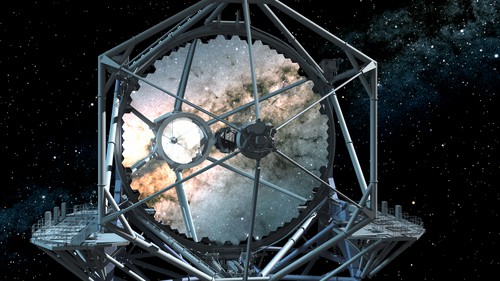
Construction of the long-delayed $1.4bn Thirty Meter Telescope (TMT) is set to soon begin after it was issued with a formal “notice to proceed” from the state of Hawaii’s Department of Land and Natural Resources (DLNR). The move marks a fresh chapter in the struggle between the international astronomical community and local Hawaiian activists, who claim that telescopes on the 4207 m-high site on Mauna Kea interfere with traditional cultural and religious practices. However, despite receiving the green light, protesters have indicated that they will continue to demonstrate against the project.
The TMT, whose primary mirror consists of 492 segments of glass pieced together, promises resolution more than 12 times sharper than images from the Hubble Space Telescope. The project originated in 2003 when Californian and Canadian universities merged three existing telescope projects to form the TMT Observatory Corporation. By 2009 an initial design had been accepted and Mauna Kea was selected as the site (see timeline below). In 2015, however, the Hawaii Supreme Court revoked the building permit following activists’ protests against construction.
In October 2018, the state Supreme Court issued a new permit for the construction of the TMT, in exchange for the closure of five of the 13 telescopes already on the site as well as the restoration of the ground they occupy to a natural state. The notice to proceed by the DLNR now allows the project to go ahead. “We remain committed to being good stewards of Mauna Kea, and to honouring and respecting the culture and traditions of Hawaii,” notes Henry Yang, chair of the TMT International Observatory’s board of governors.
Speaking out
While local officials tore down a group of protesters’ shacks and monuments on the site after the verdict, TMT officials have not yet determined exactly when construction will start. “We would like to begin construction as soon as possible and will meet with University of Hawaii [which subleases the Mauna Kea site], as well as state and county officials soon to determine an exact and appropriate start date,” says TMT spokesperson Scott Ishikawa, who adds that they will determine an updated cost for the project “once on-site construction officially begins”.

Thirty Meter Telescope project clears latest legal hurdle
The TMT’s timeline envisions first light for the observatory in July 2027. However, activists who delayed the project in 2015 have made it clear that they will not back down from continued protests at the site. Indeed, the state’s governor, David Ige, promised to respect the rights and cultural traditions of Hawaiians, including the right to speak out against the observatory.
Timeline: ups and down of the Thirty Metre Telescope
2004 Project office for the $1bn Thirty Metre Telescope (TMT) is established
2007 The Gordon and Betty Moore Foundation pledges $200m to the TMT
2009 Mauna Kea in Hawaii is selected as the site for the TMT
2013 Hawaiian environmental officials give permission for the construction of the TMT
2014 Construction of the TMT begins following the approval of a sublease by the Hawaii Board of Land and Natural Resources (BLNR)
2015 Construction is halted after protests by native Hawaiians.
2016 Hawaii’s Supreme Court rules that the construction permit for the TMT is invalid while TMT officials choose the Canary Islands as an alternative site for the planned telescope if construction does not go ahead in Hawaii
2017 The BLNR grants a construction permit for the TMT following the recommendation by a senior judge
2018 Hawaii’s Supreme Court rules that construction of the TMT can begin
2019 Hawaii’s Department of Land and Natural Resources issues the TMT with a formal “notice to proceed”



